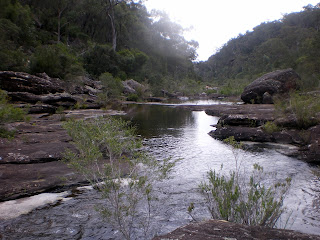My Personal Experience With Environmental Destruction Caused by Long Wall Coal Mining.
I grew up on a small farm which had been planted as an orchard in the 1960's. We farmed the orchard and the surrounding native bushland was left to nature. We occasionally drew water from the Cataract River at the back of the property when our tanks ran dry. It was a clear running creek at the bottom of a deep gorge...water never tasted this good.
After some years, BHP (then Australian Iron and Steel) established a long wall coal mine on the large property across the road. This was not an entirely welcome development locally, although St Mary's Towers, a monastery owned by the Catholic church, did derive a benefit from the sale of land for the mine and royalties on coal for a period. We did not know then what we know now. There were other mines in the district in Appin and other locations in the Sydney water catchment area between Picton and Wollongong. BHP were careful (required to?) to minimise destruction to the surrounding bushland. In the beginning, it was hard to notice a mine existed because it was hidden behind such dense native forest. We did miss being able to walk or ride on horseback through the bush, and we were no longer able to access the beautiful cave on Allens Creek, a testament to the wonderful art and culture of the Dharawal people of the district.
The mine took several years to establish, by which time our family was ready to move on, but not before coal extraction began and the trucks started rolling in and out. This was the first visible sign of pollution as at this time the waterways were still pristine, animals and birds were still seen in great numbers and there was very little noise or visual pollution.
Within a year, the roadways were black with coal dust as a steady stream of trucks filed in and out of the mine to travel the 40km trip through water catchment country to Port Kembla coal loader. The trees and rocks were black, the roadside was filthy and dead animals lined the road every morning, although this decreased in time as one could imagine the area became less habitable for native fauna. The noise increased as production became a round the clock operation, and the lights and noise at night made it difficult for residents. It only ceased when the miners went on strike. When my parents decided to pack up and go, they sold the farm to BHP, nobody else wanted to buy it.
What has happened in the subsequent 35 years of the mine’s operation is a sad tale of environmental destruction. Mine subsidence in the area damages roads and houses. It makes the surrounding river gorges unsafe due to regular rock falls. Wildlife is no longer abundant as it once was, despite little residential development. The road trees along the road are stunted and black, the soil by the roadside is tainted with black coal dust. It has devastated the local river system. Ventilation shafts, including those still being built pump methane and other gases into the atmosphere and underground the mineshafts cover many kilometres.
It is the Cataract River which flows through a deep sandstone gorge and is part of the Sydney water catchment, which formed the boundary of our family farm. In the mid 1990’s, CSG, released as a result of cracks caused by mine subsidence, devastated the river with deadly effect on ALL riparian vegetation and aquatic life. The beautiful river, where we used to swim and our neighbours would fish, became a graveyard of dead trees and shrubs. This has been well documented, and a straightforward article by Rivers SOS documents some of the damage.
Cracks from mine subsidence not only fractured the river bed causing the creek to drain, it also allowed significant amounts of high molecular weight gas components (C2+ >2.3%), including C6-C8 n-alkanes, branched alkanes, alkylcyclopentanes and alkylcyclohexanes to escape. The result of this was that the soil became anoxic, as the methane replaced oxygen in the soil. Gases escaping at a rate of more than 20l/s led to soil temperatures of over 40 degrees. Vegetation was killed by both increased temperature and oxidation of methane gas and its homologues in the soil. The carbon isotope signature of the methane was similar to that found in CSG. Added to this destructive situation was an upstream dam which restricted the natural river flow. In fact the whole Georges River system has suffered the same fate from mining, and restrictions now prevent mining under rivers in this area. This is just my first hand experience of localized damage.
At a global level, coal as a cheap form of energy fuels electricity plants and drives industry. At every step from mining, transport and its use burning to produce energy, coal causes local and global environmental damage and is a huge contributer to general air pollution and greenhouse gas emmisions.
As a result of this personal experience, I am very opposed to Coal Seam Gas Extraction and Coal Mining. Especially as we have alternative energy sources and we know the damage caused. We can't pretend a coal mine is not a disaster for any district. They are dirty, noisy, polluting, they look awful, they don't benefit the district (other than throwing money at community organizations..peanuts) and at the end of the day, it is such a short term exercise; most of these coal mines are now closing down. They took the money and ran....... very dodgy houseguests indeed.
https://www.whitehavencoal.com.au/environment/docs/part-1-subsidence-assessment-f.pdf
